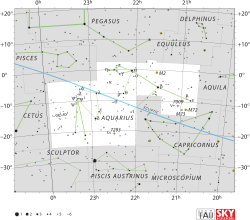Omicron Aquarii

| |
| Observation data Epoch J2000 Equinox J2000 | |
|---|---|
| Constellation | Aquarius |
| Right ascension | 22h 03m 18.84403s[1] |
| Declination | –02° 09′ 19.3067″[1] |
| Apparent magnitude (V) | +4.71[2] |
| Characteristics | |
| Spectral type | B7 IVe[3] |
| U−B color index | –0.39[2] |
| B−V color index | –0.11[2] |
| Variable type | γ Cas |
| Astrometry | |
| Radial velocity (Rv) | +11.0[4] km/s |
| Proper motion (μ) | RA: +24.66[1] mas/yr Dec.: –11.16[1] mas/yr |
| Parallax (π) | 7.49 ± 0.23[1] mas |
| Distance | 440 ± 10 ly (134 ± 4 pc) |
| Details | |
| Radius | 4.3[5] R☉ |
| Surface gravity (log g) | 3.13[6] cgs |
| Temperature | 13,464 ± 164[5] K |
| Rotational velocity (v sin i) | 282 ± 20[7] km/s |
| Other designations | |
| Data sources: | |
| Hipparcos Catalogue, CCDM (2002), Bright Star Catalogue (5th rev. ed.) | |
Omicron Aquarii (ο Aqr, ο Aquarii) is the Bayer designation for a star in the equatorial constellation of Aquarius. It has the traditional star name Kae Uh, from the Chinese 蓋屋 (Mandarin gàiwū) "the roof". Visible to the naked eye, it has an apparent visual magnitude of +4.71.[2] Parallax measurements put it at a distance of roughly 440 light-years (130 parsecs) from Earth.[1]
In Chinese, 蓋屋 (Gài Wū), meaning Roofing, refers to an asterism consisting of ο Aquarii and 32 Aquarii.[9] Consequently, ο Aquarii itself is known as 蓋屋一 (Gài Wū yī, English: the First Star of Roofing.)[10]
The spectrum of Omicron Aquarii fits a stellar classification of B7 IVe;[3] the luminosity class of IV suggests that this is a subgiant star that is exhausting the supply of hydrogen at its core and is in the process of evolving into a giant star. The 'e' suffix on the class indicates that the spectrum shows emission lines of hydrogen, thus categorizing this as a Be star. Omicron Aquarii is rotating rapidly with a projected rotational velocity of 205 km/s.[11] The rotation rate along the equator may be as high as 77% of the critical rotation velocity, with the axis of rotation being inclined by around 70° ± 20°. The emission lines are being generated by a decreted circumstellar disk of hot hydrogen gas.[7]
It is classified as a Gamma Cassiopeiae type[12] variable star and its brightness varies from magnitude +4.68 to +4.89.[13]
References
- 1 2 3 4 5 6 van Leeuwen, F. (November 2007), "Validation of the new Hipparcos reduction", Astronomy and Astrophysics, 474 (2): 653–664, arXiv:0708.1752
 , Bibcode:2007A&A...474..653V, doi:10.1051/0004-6361:20078357.
, Bibcode:2007A&A...474..653V, doi:10.1051/0004-6361:20078357. - 1 2 3 4 Feinstein, A.; Marraco, H. G. (November 1979), "The photometric behavior of Be Stars", Astronomical Journal, 84: 1713–1725, Bibcode:1979AJ.....84.1713F, doi:10.1086/112600.
- 1 2 Lesh, Janet Rountree (December 1968). "The Kinematics of the Gould Belt: an Expanding Group?". Astrophysical Journal Supplement. 17: 371. Bibcode:1968ApJS...17..371L. doi:10.1086/190179.
- ↑ Wielen, R.; et al. (1999), Sixth Catalogue of Fundamental Stars (FK6). Part I. Basic fundamental stars with direct solutions (35), Astronomisches Rechen-Institut Heidelberg, Bibcode:1999VeARI..35....1W.
- 1 2 Underhill, A. B.; et al. (November 1979), "Effective temperatures, angular diameters, distances and linear radii for 160 O and B stars", Monthly Notices of the Royal Astronomical Society, 189: 601–605, Bibcode:1979MNRAS.189..601U, doi:10.1093/mnras/189.3.601.
- ↑ Soubiran, C.; Le Campion, J.-F.; Cayrel de Strobel, G.; Caillo, A. (June 2010), "The PASTEL catalogue of stellar parameters", Astronomy and Astrophysics, 515: A111, arXiv:1004.1069
 , Bibcode:2010A&A...515A.111S, doi:10.1051/0004-6361/201014247.
, Bibcode:2010A&A...515A.111S, doi:10.1051/0004-6361/201014247. - 1 2 Meilland, A.; Millour, F.; Kanaan, S.; Stee, Ph.; Petrov, R.; Hofmann, K.-H.; Natta, A.; Perraut, K. (February 2012), "First spectro-interferometric survey of Be stars. I. Observations and constraints on the disk geometry and kinematics", Astronomy & Astrophysics, 538: A110, arXiv:1111.2487
 , Bibcode:2012A&A...538A.110M, doi:10.1051/0004-6361/201117955.
, Bibcode:2012A&A...538A.110M, doi:10.1051/0004-6361/201117955. - ↑ "omi Aqr -- Be Star", SIMBAD Astronomical Object Database, Centre de Données astronomiques de Strasbourg, retrieved 2012-07-03.
- ↑ (Chinese) 中國星座神話, written by 陳久金. Published by 台灣書房出版有限公司, 2005, ISBN 978-986-7332-25-7.
- ↑ (Chinese) AEEA (Activities of Exhibition and Education in Astronomy) 天文教育資訊網 2006 年 5 月 16 日
- ↑ Abt, Helmut A.; Levato, Hugo; Grosso, Monica (July 2002), "Rotational Velocities of B Stars", The Astrophysical Journal, 573 (1): 359–365, Bibcode:2002ApJ...573..359A, doi:10.1086/340590.
- ↑ "omi Aqr", General Catalogue of Variable Stars, Sternberg Astronomical Institute, retrieved 2012-07-03. Note: type = GCAS.
- ↑ Ruban, E. V.; et al. (September 2006), "Spectrophotometric observations of variable stars", Astronomy Letters, 32 (9): 604–607, Bibcode:2006AstL...32..604R, doi:10.1134/S1063773706090052.